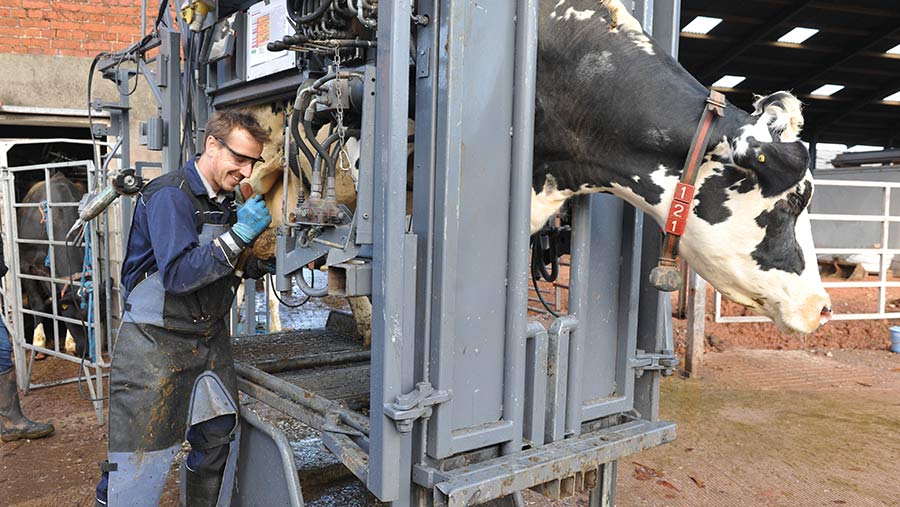How a strict approach to mobility scoring can cut lameness
 © Debbie James
© Debbie James Fortnightly mobility scoring followed by prompt treatment of foot health issues have helped a Welsh dairy farm to cut its herd lameness levels to less than 10%.
Russell Morgan and his team at Graig Olway Farm, Usk, have worked with vet Sara Pedersen on a project to reduce the incidence of lameness since the farm became a Farming Connect Demonstration Farm three years ago.
At the start of the project, 49% of the 170-cow Holstein herd was lame – the main causes identified were sole ulcers and digital dermatitis. “Our foot health was not good enough,” admits Mr Morgan.
See also: How to tackle chronic dairy cow lameness and mobility
Improvements
Ms Pedersen, who specialises in cattle foot health, tackled the herd’s lameness by implementing the AHDB Healthy Feet Programme.
This involved formulating an action plan including a “blitz” treatment regime for digital dermatitis followed by a more effective foot-bathing system to keep infection levels low.
Milkers are now foot-bathed four times a week and dry and transition cows three times.
Other changes included replacing cubicle mattresses and adjusting shed ventilation to improve cow comfort and reduce the risk of sole ulcers.
Farm facts
- Farming 240ha (593 acres)
- Dairy, beef and arable enterprises
- Robot milking
- Year-round calving
One of the most important changes was the introduction of fortnightly, rigorous mobility scoring, which is undertaken by Mr Morgan’s partner, Sarah.
“When you set the threshold for lameness low, you will inevitably see more cows in the crush than you need to see, but you get all those that you do. This is crucial to success,’’ says Ms Pedersen.
The mobility scores are used to select the most appropriate cows for inspection. The latest evidence-based treatment is then applied.
This includes the application of a block and three days of non-steroidal, anti-inflammatory pain relief for new cases of claw horn lesions, for example, sole bruising.
“This has resulted in a quicker recovery of cases and fewer repeat cases, too. Catching cases early means better outcomes,” says Ms Pedersen.
Cows at Graig Olway that are flagged up with possible mobility issues are inspected at the fortnightly trimming sessions by the farm’s professional foot-trimmer, Alan Colebatch, a fully audited Cattle Hoof Care Standards Board member.
The importance of employing a highly skilled foot-trimmer in the team cannot be understated, says Ms Pedersen.
“The results at Graig Olway have shown this, and working alongside Alan Colebatch has been fundamental to the success we have seen.
“A lot of damage can be done by poor trimming technique and, unfortunately, this is something we see too commonly.’’
Foot-trimming at Graig Olway costs about £800 a month for the twice-monthly sessions.
“With levels of lameness now at our target levels, we did think of reducing it to once every three weeks or every month, but it is money well spent so we will be maintaining it as fortnightly,” says Mr Morgan.
Improvements in foot health
As part of its milk contract, the farm has a spot audit, which includes a mobility score by the milk buyer’s veterinary consultant.
The latest audit result recorded a lameness prevalence of 11% in the milking herd, which reduced to less than 10% at a herd level when the dry cows were included.
Mr Morgan admits that solving lameness was not an “overnight fix’’ but a long-term process.
“There are ups and downs along the way, as we have seen, but the key is to keep going,’’ he says.
Morgan Russell and Sara Pederson were speaking at a recent Farming Connect event at the farm.
